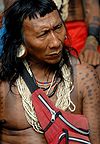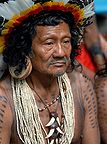Rikbaktsa people
   
|
|
| Total population | |
|---|---|
| 909 | |
| Regions with significant populations | |
| Brazil | |
| Languages | |
| Rikbaktsa, Portuguese | |
| Religion | |
| Animism |
The Rikbaktsa are an indigenous ethnic group from the Mato Grosso region of Brazil.
Rikbaktsa (Rikbaktsa rik, person + bak, human being + tsa [plural suffix]), the group's self-denomination, can be translated as "the human beings". Variant spellings include Ricbacta, Erikbaktsa, Erigpaktsa, Erigpagtsá, Erigpactsa, Erikbaktsá, Arikpaktsá, and Aripaktsá. Locally, they are also called Canoeiros (Canoe People), alluding to their aptitude in canoe use, or—more rarely—Orelhas de Pau (Wooden Ears), alluding to their practice of enlarging their earlobes with wooden plugs.
The Rikbaktsa live in the Amazon rain forest of northwest Mato Grosso. Their traditional territory spanned 50,000 km² of Juruena River basin, stretching from the Papagaio River in the south to the Augusto Falls on the upper Tapajós River in the north. Their territory was bounded on the west by the Aripuanã River and on the east by the Arinos River, near the Peixes River.
Today, they have rights to three Indigenous Lands: Erikbaktsa (79,935 hectares, demarcated in 1968), Japuíra (152,509 hectares, demarcated in 1986), and Escondido (168,938 hectares, demarcated in 1998).
There are no pre-20th century historical references to the Rikbaktsa, and there have been no archeological studies to date their occupation of their traditional lands. However, oral histories, geographic references in their myths, and their detailed knowledge of nearby flora and fauna suggest that they have lived on the land for some time.
Though scientific, commercial, and strategic expeditions have visited the region surrounding the Rikbaktsa since the 17th century, they stayed on the waterways and did not venture into the forests in which the Rikbaktsa lived. It was not until rubber gatherers came to the region in the late 1940s that the first historical references to Rikbaktsa people appeared. The Rikbaktsa, who were known for their hostile relations with nearly every neighboring indigenous group, initially resisted the presence of rubber gatherers. The Rikbaktsa were finally "pacified" by rubber planter–financed Jesuit missionaries between 1957 and 1962, when they stopped resisting the planters. After 1962, the rubber-extraction, timber, mining, and agricultural industries encroached on the Rikbaktsa's traditional territory.
...
Wikipedia
